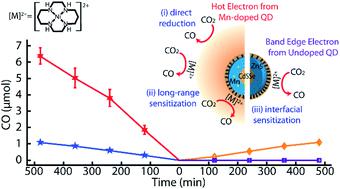当前位置:
X-MOL 学术
›
J. Mater. Chem. A
›
论文详情
Our official English website, www.x-mol.net, welcomes your
feedback! (Note: you will need to create a separate account there.)
Breaking the short-range proximity requirement in quantum dot/molecular catalyst hybrids for CO2 reduction via long-range hot electron sensitization
Journal of Materials Chemistry A ( IF 10.7 ) Pub Date : 2020-06-17 , DOI: 10.1039/d0ta05258b David Parobek 1, 2, 3, 4 , Jeremy R. Meeder 1, 2, 3, 4 , Joseph Puthenpurayil 1, 2, 3, 4 , Michael Nippe 1, 2, 3, 4 , Dong Hee Son 1, 2, 3, 4, 5
Journal of Materials Chemistry A ( IF 10.7 ) Pub Date : 2020-06-17 , DOI: 10.1039/d0ta05258b David Parobek 1, 2, 3, 4 , Jeremy R. Meeder 1, 2, 3, 4 , Joseph Puthenpurayil 1, 2, 3, 4 , Michael Nippe 1, 2, 3, 4 , Dong Hee Son 1, 2, 3, 4, 5
Affiliation

|
The efficient light-driven fuel production from homogeneous photocatalytic systems is one promising avenue towards an alternative energy economy. However, electron transfer from a conventional photosensitizer to a catalyst is short-range and necessitates spatial proximity between them. Here we show that energetic hot electrons generated by Mn-doped semiconductor quantum dots (QDs) allow for long-range sensitization of Ni(cyclam)-based molecular catalysts, enabling photocatalytic reduction of CO2 to CO without requiring chemical linkages between the QDs and catalyst molecules. Our results demonstrate the potential of hot electron sensitization in simplifying the design of hybrid catalyst systems while improving photocatalytic activity.
中文翻译:

通过远距离热电子敏化,打破了量子点/分子催化剂混合物中减少二氧化碳排放的近距离要求
从均相光催化系统高效生产光驱动燃料是通往替代能源经济的一种有前途的途径。但是,从常规光敏剂到催化剂的电子转移是短距离的,并且需要它们之间的空间接近性。在这里,我们显示了由Mn掺杂的半导体量子点(QD)产生的高能热电子可以对基于Ni(cyclam)的分子催化剂进行远距离敏化,从而可以实现将CO 2光催化还原为CO而不需要QD之间的化学键和催化剂分子。我们的结果证明了热电子敏化在简化杂化催化剂体系设计的同时提高光催化活性的潜力。
更新日期:2020-07-07
中文翻译:

通过远距离热电子敏化,打破了量子点/分子催化剂混合物中减少二氧化碳排放的近距离要求
从均相光催化系统高效生产光驱动燃料是通往替代能源经济的一种有前途的途径。但是,从常规光敏剂到催化剂的电子转移是短距离的,并且需要它们之间的空间接近性。在这里,我们显示了由Mn掺杂的半导体量子点(QD)产生的高能热电子可以对基于Ni(cyclam)的分子催化剂进行远距离敏化,从而可以实现将CO 2光催化还原为CO而不需要QD之间的化学键和催化剂分子。我们的结果证明了热电子敏化在简化杂化催化剂体系设计的同时提高光催化活性的潜力。











































 京公网安备 11010802027423号
京公网安备 11010802027423号